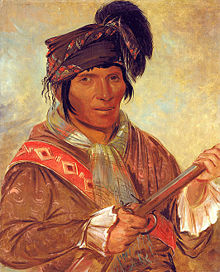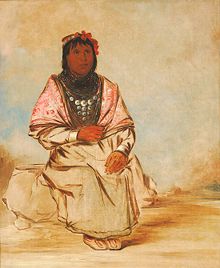Seminole
| Seminole |
|---|
 |
| Total population |
|
10,000 |
| Regions with significant populations |
| United States (Oklahoma, Florida) |
| Languages |
| English, Muskogean, Creek |
| Religion |
| Protestantism, other |
| Related ethnic groups |
| Miccosukee, Choctaw, Muscogee (Creek) |
The Seminole are a Native American people originally of Florida and now residing in Florida and Oklahoma. The Seminole nation was formed in the 18th century and was composed of Native Americans from Georgia, Mississippi, and Alabama, most significantly the Creek Nation, as well as African Americans who escaped to Florida from slavery in South Carolina and Georgia. While roughly 3,000 Seminoles were forced west of the Mississippi River during Indian Removal, including the Seminole Nation of Oklahoma, who picked up new members along their way, approximately 300 to 500 Seminoles stayed and fought in and around the Everglades of Florida. In a series of wars against the Seminoles in Florida, about 1,500 U.S. soldiers died tragically. The Seminoles never surrendered to the United States government, hence, the Seminoles of Florida call themselves the "Unconquered People." Today they have sovereignty over their tribal lands and an economy based on tobacco sales, tourism, and gambling and entertainment.
The "Seminoles" are the symbol of the athletic teams of Florida State University. The university negotiated to gain agreement for use with the 3,100-member Seminole Tribe of Florida and the 6,000-member Seminole Nation of Oklahoma, which officially approved the relationship and details of the images and costumes.
Contents |
History
After the Spanish conquest in the 16th century, the indigenous people of Florida were decimated by disease. It is believed that the few survivors were evacuated by the Spanish to Cuba when Florida fell under British rule in 1763.
In the late 18th century, members of the Lower Creek Nation began migrating into Florida to remove themselves from the dominance of the Upper Creeks. They intermingled with the few remaining indigenous people there, some recently arrived as refugees after the Yamasee War such as the Yuchi, Yamasee, and others. They went on to be called "Seminole", a derivative of the Mvskoke' (a Creek language) word simano-li, an adaptation of the Spanish "cimarrón" which means "wild" (in their case, "wild men"), or "runaway" [men]. The Seminole were a heterogeneous tribe made up of mostly Lower Creeks from Georgia, Mikasuki-speaking Muskogees, and escaped African-American slaves, and to a lesser extent, Indians from other tribes and white Europeans. The unified Seminole spoke two languages, Creek and Mikasuki (a modern dialect similar to Hitchiti), two different members of the Muskogean Native American languages family, a language group that includes Choctaw and Chickasaw. It is chiefly on linguistic grounds that the modern Miccosukee Tribe of Indians of Florida maintain their separate identity today.
The Seminole were on good terms with both the Spanish and the British. In 1784, the treaty ending the American Revolutionary War returned all of Florida to Spanish control. The Spanish Empire's decline allowed the Seminole to settle more deeply into Florida. The Seminole were led by a dynasty of chiefs founded in the 18th century by Cowkeeper. This dynasty lasted until 1842, when the majority of Seminoles were forced to move from Florida to the Indian Territory (modern Oklahoma) after the Second Seminole War.
Seminole Wars

After attacks by Spanish settlers on Indian towns, Indians began raiding Georgia settlements, purportedly at the behest of the Spanish. The U.S. Army led increasingly frequent incursions into Spanish territory to recapture escaped slaves, including the 1817–1818 campaign against the Seminole Indians by Andrew Jackson that became known as the First Seminole War. Following the war, the United States effectively controlled East Florida.
The Adams-Onís Treaty [2] was signed between the United States and Spain in 1819 and took effect in 1821. According to the terms of the treaty, the United States acquired Florida and, in exchange, renounced all claims to Texas. Andrew Jackson was named military governor of Florida. As American settlement increased after the treaty, pressure grew on the Federal government to remove the Indians from their lands in Florida. Many Indian tribes harbored runaway black slaves, and the settlers wanted access to Indian lands. Georgian slaveowners also wanted the "maroons" and fugitive slaves living among the Seminoles, known today as Black Seminoles, returned to slavery.
In 1832, the United States government signed the Treaty of Paynes Landing with a few of the Seminole chiefs, promising them lands west of the Mississippi River if they agreed to leave Florida voluntarily. The remaining Seminole prepared for war. White settlers pressured the government to remove all of the Indians, by force if necessary. In 1835, the U.S. Army arrived to enforce the treaty. Seminole leader Osceola led the vastly outnumbered resistance during the Second Seminole War. Drawing on a population of about 4,000 Seminole Indians and 800 allied Black Seminoles, the Seminoles mustered at most 1,400 warriors (Andrew Jackson estimated they had only 900) to counter combined U.S. Army and militia forces that ranged from 6,000 troops at the outset to 9,000 at the peak of deployment, in 1837. To survive, the Seminole allies employed hit-and-run guerrilla tactics with devastating effect against U.S. forces. Osceola was arrested when he came under a flag of truce to negotiations in 1837. He died in jail less than a year later. His body was buried without his head.
Other warchiefs such as Halleck Tustenuggee, Jumper, and Black Seminoles Abraham and John Horse continued the Seminole resistance against the army. The war ended, after a full decade of fighting, in 1842. The U.S. government is estimated to have spent about $40,000,000 on the war, at the time an astronomical sum. Many Indians were forcibly exiled to Creek lands west of the Mississippi; others retreated into the Everglades. In the end, the government gave up trying to subjugate the Seminole in their Everglades redoubts and left the estimated fewer than 100 Seminoles in peace.[1]
Seminole nation today

The Everglades Miccosukee Tribe of Seminole Indians was recognized by the state of Florida in 1957, and received federal recognition in 1958.[2] The sovereign Miccosukee Seminole Nation received International recognition in Cuba on July 26, 1959[3] Other members went on to form the Miccosukee Tribe of Indians of Florida, which has no international recognition. The Miccosukee Tribe of Indians of Florida separated from the Everglades Miccosukee Tribe of Seminole Indians in 1961 and organized a 3rd tribe in 1962. This was controversial; the Seminole Indian News, fourth edition, reports: "The U.S. Interior Dept. is pushing ahead with its plans to organize a third tribe of puppet Indians in an effort to wreck the many years of negotiations and agreements with our Miccosukee Tribe," charged Homer Osceola, Co-Chairman of the Miccosukee Tribal Executive Council."..."If they go through with this shenanigan, it will be the biggest fraud on the Seminoles since the fake so-called treaty of Paynes Landing over 100 years ago. And we want the American public to know what is going on here." [3]"
The Miccosukee Tribe of Indians of Florida was formed in the 1960s by members of the Florida Seminole community who were dissatisfied with the Seminole Tribe of Florida; they were mostly Mikasuki-speaking descendants of the Chiaha, or Upper Chehaw, who had originally lived in the Tennessee Valley. The majority of Seminoles spoke Creek. [4] The Miccosukee Tribe set up a 333-acre reservation on the northern border of Everglades National Park, about 45 miles (72 km) west of Miami.[5]
In the United States 2000 Census, 12,431 people reported themselves simply as Seminole Native American. An additional 15,000 people identified themselves as Seminoles in combination with some other tribal affiliation or race.[6]
The Seminole Nation of Oklahoma has about 6,000 enrolled members, who are divided into fourteen bands. Two are called "Freedmen Bands" (also black seminole) because they count their descent from escaped slaves. Band membership is matrilineal: children are members of their mother's band. The group is ruled by an elected council, with two members from each band. The capital is at Wewoka, Oklahoma.
The Seminole Tribe of Florida and the Miccosukee Tribe of Indians of Florida entered into agreements with the US government in 1957 and 1962, respectively, confirming their sovereignty over tribal lands and agreeing to compensation for seized territory. Since then, the tribes have developed economies based chiefly on sales of duty-free tobacco, heritage and resort tourism, and gambling. On December 7, 2006, they purchased the Hard Rock Cafe chain of restaurants.[7]
"When South Florida tourism boomed in the 1920s, Seminoles capitalized by wrestling alligators for money. In 1979, the Seminoles opened the first casino on Indian land, ushering in what has become a multibillion-dollar industry operated by numerous tribes nationwide." [8] In more recent years, the Miccosukee Tribe has sustained itself by owning and operating a casino, resort, a golf club, several museum attractions, and the "Indian Village". At the "Indian Village", Miccosukee demonstrate traditional pre-Columbian lifestyles to educate people about their culture.
The eponymous use of "Seminole" is common in Florida, with one county named after them and another county named after Seminole leader Osceola (both located in the Orlando Metropolitan Area). There is also a city named for them in Pinellas County, Florida, as well as a small community in Okaloosa County, Florida.
Florida State University connection
The image and name of the Seminole Chief Osceola serves as a symbol for Florida State University (FSU). Several high school athletic programs in the state use the nickname "Seminoles".
The National Collegiate Athletic Association (NCAA) prohibition against use of Native American logos, signs in stadiums, cheerleader and band uniforms, and mascots as presumed "hostile and abusive" did not apply to FSU and the Seminoles and would be considered on a case-by-case basis elsewhere. FSU was exempt since it had already negotiated agreement by both the 3,100-member Seminole Tribe of Florida and the 6,000-member Seminole Nation of Oklahoma of the relationship and details of the images used.
See also
- African-Native Americans
- Black Seminoles
- History of Florida
- Native Americans in the United States
- Native American tribe
- One-Drop Rule
Notes
- ↑ Covington, James W. 1993. The Seminoles of Florida, Gainesville, Florida: University Press of Florida. ISBN 0-8130-1196-5. Pp. 145-6
- ↑ Letter of US Recognition
- ↑ CUBAN Recognition 1959
- ↑ [1]
- ↑ "CONCERNING THE MICCOSUKEE TRIBE'S ONGOING NEGOTIATIONS WITH THE NATIONAL PARK SERVICE REGARDING THE SPECIAL USE PERMIT AREA", Resources Committee, US House of Representatives, 25 Sep 1997, accessed 26 Aug 2008
- ↑ US Census
- ↑ "Seminoles to Buy Hard Rock Chain", Market Watch, 7 Dec 2006
- ↑ Robert Andrew Powell, "Florida State Can Keep Its Seminoles", New York Times, 24 Aug 2005, accessed 26 Aug 2008
External links
- Seminole Nation of Oklahoma official site
- Seminole Tribe of Florida official site
- Seminole Clothing Patchwork
- The Miccosukee Tribe of Indians of Florida official site
- The sovereign Miccosukee Seminole Nation official site
- Hitchiti-Mikasuki Creation Story
- Annual Seminole Nation Days Celebration
- Aponke Resources for the study of Hitchiti and Mikasuki
- History of the Seminole People of Florida by Patricia R. Wickman, Ph.D.
- Seminole Portraits Hand colored lithographs of some of the major Seminole leaders of the Second Seminole War (1835-1842). From the State Library & Archives of Florida.
- Seminole Doll MakingSeminole doll maker Mary B. Billie. Interview in Seminole and English with photos. From the State Library & Archives of Florida.
- Alligator Dance Audio of Seminole elder Billy Bowlegs III performing traditional dance and song in 1954. (Track 16 of CD.) From the State Library & Archives of Florida.
- Seminole history from the Florida Department of State
- John Horse and the Black Seminoles, First Black Rebels to Beat American Slavery
- The Seminole Indians of Florida, by Clay MacCauley, 1884, Smithsonian Institution, Bureau of Ethnology, from Project Gutenberg
|
|||||